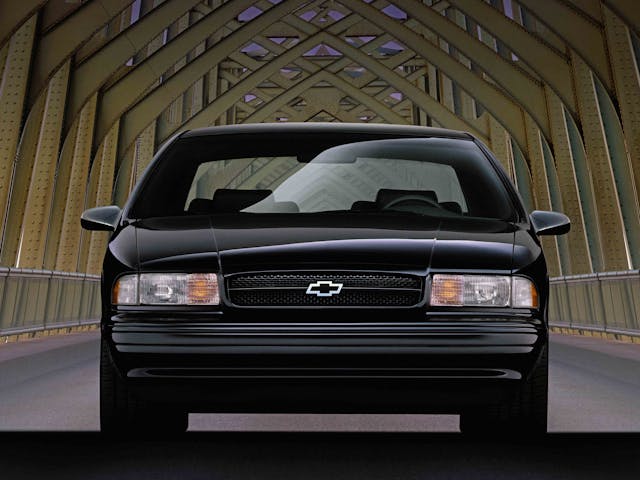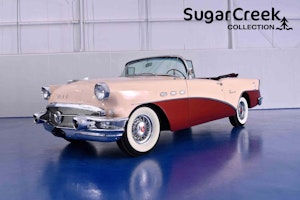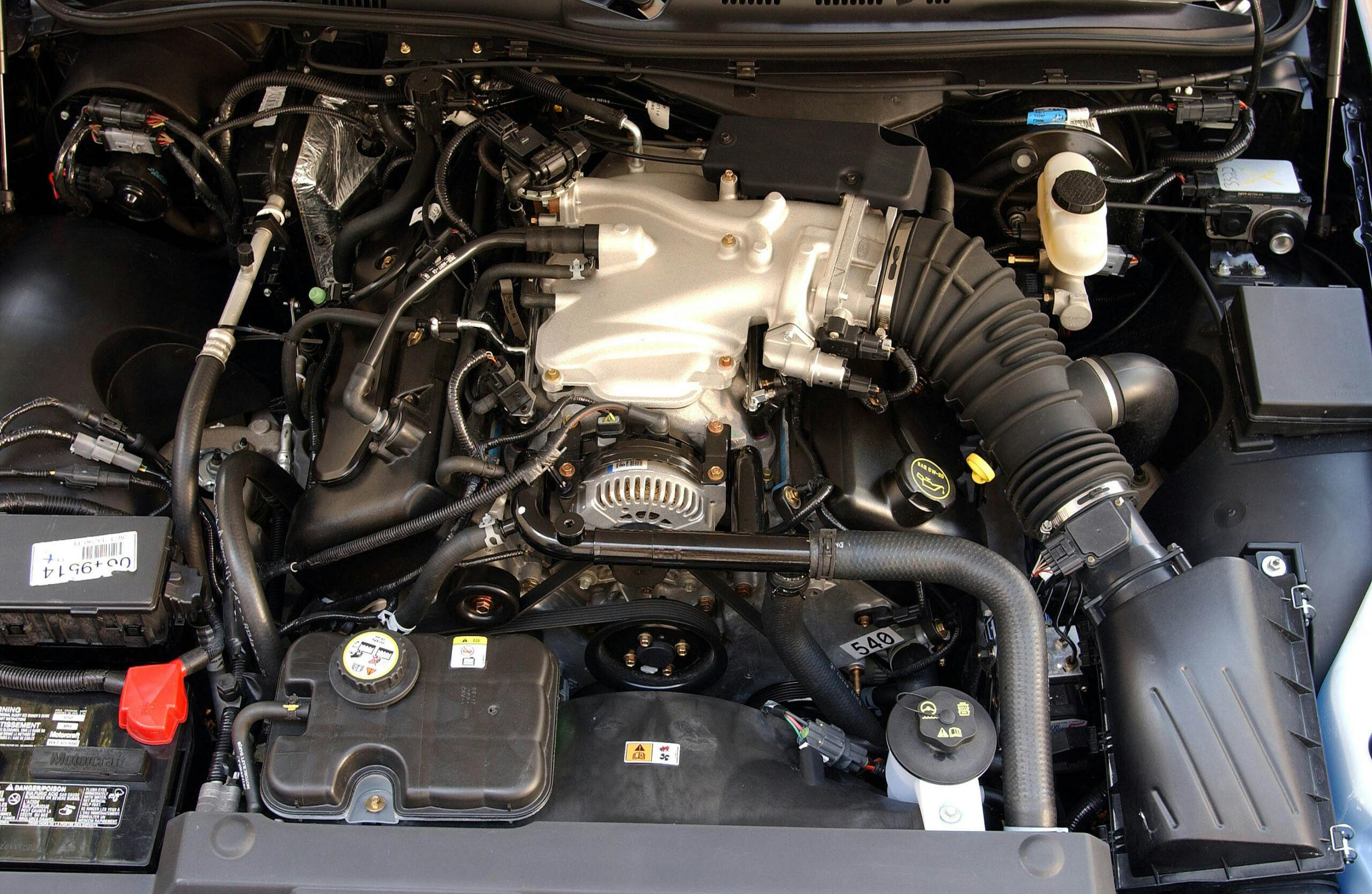Media | Articles
The Chevy Impala SS and Mercury Marauder are classic American sleepers
For a beautiful time in the 1950s, ’60s, and ’70s, automakers had imagination, family cars looked stunning, and if you had the extra coin, you could spec them with some real power under the hood.
Fast forward to the 1990s, and most of the excitement had long since left the family-hauling slice of the new-car market. We were in full transition mode, from an era of boxes on wheels to one of jellybeans on wheels. Sure, there were still fun cars to be had, but most of them weren’t exactly practical to own and drive on a daily basis.
As the decade came to a close and SUVs and crossovers replaced full-size cars as family haulers, there were still a few holdouts roaming the streets—big, V-8-powered, rear-wheel-drive machines. Your Grand Marquis, Crown Victorias, and Caprices, even the Roadmaster. They came with a live rear axle and enough room for the family, and they made for perfectly boring commuter cars.
Though the segment slowly died out, two platforms soldiered on—the GM B-body and Ford’s Panther. Both sported underpinnings dating back to the late 1970s, with enough design changes and drivetrain updates over the years to keep them relevant. That said, enthusiasts and people who remembered big-bodied performance from decades before weren’t paying much attention to either platform.
Then came two swan song specials. Today we owe some thanks to those performance die hards within the industry who took two of the blandest family cars on earth and turned them into a duo we never asked for but needed so badly: The Chevrolet Impala SS and the Mercury Marauder.
Marketplace
Buy and sell classics with confidence
Chevrolet Impala SS

General Motors gave the full-size B-body a total redesign in 1991. Visually, the changes were night and day, with the old sharp-edged boxy body giving way to a whale on wheels. But that’s where the differences ended. Underneath, the chassis remained nearly identical to the one introduced in 1977. A year later, however, that would all change, when Chevrolet introduced its Impala SS concept at the Detroit auto show. The brainchild of designer Jon Moss, the concept took a standard Caprice, blacked out all the trim, and stuffed a 510-cubic-inch V-8 engine under the hood. By 1994, the first Impala SS production cars were rolling off the assembly line, 25 years after the name had been canceled.
As with any production car, the final product was different from the concept. The big-block was replaced by the powerful-for-the-time 350-cubic-inch LT1 V-8, which made 260 hp. An upgraded suspension came from the 9C1 package used for police cars, a limited-slip differential was installed, and the rear brakes were upgraded to discs. Exterior designers did the best they could with what they had to work with, which simply meant a total lack of chrome, a set of big five-spoke wheels, and a lowered stance. It was all just menacing enough.
Performance was decent for the time, with 0 to 60 mph coming in around 7 seconds—not too shabby for a two-ton monster. By today’s standards, of course, such a figure can be achieved by most daily drivers. But in the context of the era, it was some feat. Sales topped 69,000 units in just three years of production.
These Impalas are relatively robust cars. That’s the benefit of that tried-and-true chassis. In fact, the biggest gripes are common to the LT1 engine. The Optispark ignition system sits under the water pump and can be problematic—and difficult to replace. By this point, however, most cars with the issue have already had it addressed with upgraded parts. The only other glaring issue is the car’s interior, as GM interior quality from the 1990s is not great, and the leather upholstery wears quickly. A low-mile, low-use example is the best way around this issue; otherwise, an interior refresh might be in the cards.
Mercury Marauder

Based on the fourth generation of the Ford Panther platform, the Mercury Marauder follows a similar trajectory to that of the Impala SS, which preceded it by a decade. The Panther is another full-frame, full-size, rear-wheel-drive platform dating to the late 1970s. Much like the GM B-body, it was also popular for underpinning full-size commuter cars as well as fleet and police cars.
The Marauder made its first appearance at the 2002 Chicago auto show as a concept car sporting a supercharged 4.6-liter V-8. Sadly, like the Impala SS concept, the Marauder would be toned down somewhat when it entered production in 2003. Similar to the Impala SS improvements, the Grand Marquis–based Marauder came with a monochromatic paint scheme, an upgraded suspension from the Crown Victoria’s Police Interceptor package, and a stronger driveline.
Output was rated at 302 hp, thanks to the four-valve 4.6-liter Modular V-8 also used in the Mustang Mach 1. The rear axle had a 3.55:1 ratio with a limited-slip differential, versus the Impala’s 3.08:1, and the Marauder tipped the scales at 4200 pounds. It made the sprint from 0 to 60 mph in 7.5 seconds, half a second slower than the Impala, despite having the horsepower and gearing advantage. Unfortunately for enthusiasts, the Marauder was canceled after just two years and production of just over 11,000 cars.
Reliability isn’t an issue in these cars. Like the Impala, the Marauder sits on a proven platform, so serious issues are not common. Most problems center on issues common to the Ford Modular engine—coolant leaks and misfires due to compression loss. As with the Impala’s LT1, by this point, such issues have likely been addressed. Other reported pitfalls have to do with blistering paint and headlight malfunctions.
What’s the market for these cars?
Digging into who is buying these cars yielded some surprising results. Being so similar in styling and purpose, it would be easy to assume that both cars have the same type of buyer. That’s not the case. We found that the overwhelming majority of Impala SS owners are Gen X, while Baby Boomers prefer the Marauder, with a nearly equal amount of interest in both cars from Millennials. It is also worth pointing out that with more than six times the number of Impalas produced, there is far more activity surrounding the Impala.
Values, however, are neck and neck, with the Impala being the slightly more expensive option. A #2 condition (Excellent) Impala SS will run you under $30,000, while a driver-quality #3 (Good) car is still in the mid-teens. Looking at the Marauder, a #2 condition (Excellent) example will cost a hair over $20,000, while a driver-quality #3 (Good) car can be had for around $12,000.
All things considered, this is a lot of bang for the buck to get into a collector car. Granted, by today’s standards, each looks far more badass than they are fast, but both were considered legit performance cars of their time, and they will still turn heads. Even when you’re just out running errands with the family.
***
Check out the Hagerty Media homepage so you don’t miss a single story, or better yet, bookmark it. To get our best stories delivered right to your inbox, subscribe to our newsletters.
Via Hagerty Insider





















I own a 1995 Chevy Caprice 9c1. Just a impressive car. Nothing comes close to leaving a smile on my face.
Where is the best sleeper? 1989 SHO Taurus.
I had three generations of that super sleeper. Now drive a first gen CTS-V. Reminds me of my 89 SHO. But more power. And it’s a manual like the first gen SHO.
I have a 96 in the grey green metallic. Bought in 99. I trip to my tuner guy totally woke this barge up.
Around 400 bhp. Handles great, and surprise those who encounter it.
I am original owner of 2006 CTSV. 4 door LS2 400 hp 6 speed man trans. My fav car will never sell. Drive only in summer.
Cadillac is currently only North American rear wheel drive car.
Nope – Dodge Charger and Chrysler 300 are mostly RWD, at least for a little longer.
Hey Chuck Cayo, Mopar or no car ! My 2016 300S is the best I’ve owned. Sport suspension, Hemi power, and 30MPG @ highway speed in the 4 cyl. mode.
I see no women commenting. I would not rest until my husband bought me the impala..he would not buy a column shift car, but, guess what! Along came the 1996 model! Mine is so loved by me, and has less than thirty thousand miles. I am the only driver since my spouse tried to take it over its limits once too often, almost wrecking it! We get along much better these days. He can easliy buy his own hot rod, but never does.
Either car is good choice. Don’t like the jelly bean styling, but at least they are not SUV’s. They tout SUV’s as having more room inside, but the ones I have ridden in seem close due to huge consoles.
The 1989 Taurus SHO was running 15 second quarter mile times and 143 mph top end five years before the SS hit the market. Granted, it was advertised as a performance sedan but so were the SS and the Mercury. In appearance it look nearly like a standard Taurus excepting the rear bumper call-out. It was a performance bargain at around $19K.
In 1965, I had three high school classmates who owned (ok, dad bought) the following
1963 1/2 Ford Galaxie 500 XL 406ci,
1964 Ford Galaxie 500 XL 427ci
1964 Mercury Marauder 427 (428?)
What I recall is that they were fast…However, Speedway Blvd. in Tucson supplied faster on Saturday night.
The real upshot of this post is there have been, and in one form or another, and will probably always be a “road slammer” somewhere. You just gotta look. And you gotta look hard!
Great article. Thanks
THE American “sleeper sedan” is the one I purchased last summer: a 2018 Ford Taurus SHO. I have owned over 60 cars, foreign and domestic from a lowly 1990 Rabbit diesel to a 2008 Mercedes Benz CLK 63 AMG Black series. Nothing compares to the overall performance, drivability, and overall over the road comfort to this SHO. Period. I have enjoyed faster, quicker, and better handling cars including STI’s and Evo MR’s as well as Porsches and Corvettes, but on balance, this SHO I will never sell!
Yawn!
So it looks like Hagerty is trying to fabricate another “collector” class of customers. Nothing says excitement like a 4 door sedan.
In 2003 FMC also produced about 3200 Mercury Grand Marquis LSE vehicles. that looked like a Mercury LS. That was a sleeper. Unfortunately, in 2015 the car was rear ended at a red light in Florida and Progressive bought it from me. The adjuster came with a low buyout price, which I advised was not enough His reply was, “It’s a plain Grand Marquis LS”. I replied, it’s an LSE check the vin. His second offer went up another $1,400. The 2003 LSE’s were produced May to Dec 2003. Why, that is another story.
The 1994-1996 Impala was truly Gm’s last best engineered B platforms. I bought a 1995 Impala SS new. I was NAISSO member #11. I modified it,raced it,beating the heck out of it for 150Kmiles. Hard to break this ride.Bought a 2nd 1995 pristine,unmolested ImpalaSS. Transferred my mods.naturally aspirated.Car launches 0-60mph in 6 seconds and runs 13sec. qtr mile in 90degree Fla heat.Engine driveline mods: k&n intake, 1.6roller rockers w/stiffer valve springs, headers, atr custom exhaust/cat. delete.Auburn limited slip rear with 3.42 gear ratio.Suspension mods: hotchkiss sway bars,9C1 frame to body bushings behind front wheels, higher rate rear springs, shocks, and energy suspension poly bushings in upper/lower rear control arms.Add 100 octane fuel. OMG!!
Both are pretty cool and I wouldn’t turn either down. For the price though…you could get a nice early 300C which yes a little newer is a a lot of bang for the Buck in a rwd V8 4 door sedan.